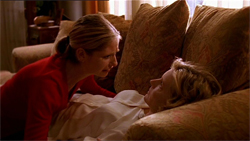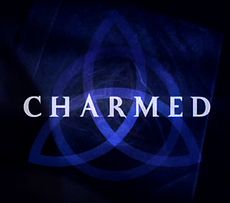Farscape: Durka Returns / A Human Reaction
DVD / ADV Films / November 2001
With Space: The Imagination Station and other Canadian stations taking their merry old time rolling out new episodes of Farscape (the third season has aired in the UK, while Canada has only seen the first half of season one in most markets), it makes more sense to shell out the money for the DVDs from ADV Films.
Farscape really gets its groove on with the eighth DVD in the series featuring the episodes “Durka Returns” and “A Human Reaction.”
The first episode is notable for introducing the character of Chiana, played by Gigi Edgley, as well as delving into Rygel’s past. Moya’s pregnancy is having an adverse effect on her systems, and she comes out of starburst just time to collide with an unidentified vessel. Moya is unharmed, but Pilot insists on bringing the damaged vessel aboard.
The first passenger to emerge from the craft is immediately recognized by Rygel as Durka, once captain of the Peacekeeper command carrier Zelbinion, and the administrator of his torture and suffering cycles ago. The man confirms that he is Durka, and it’s John that must hold the enraged Hynerian at bay. However, Durka is not the man he used to be, according to Salis, a Nebari. His brain has been altered over the years – about 100 cycles. For all intents in purposes, Durka has been neutered, but Rygel is not convinced.
There’s a third passenger about the Nebari vessel – another gray-skinned Nebari named Chiana. She’s actually a prisoner, and Durka requests a cell to place her until another Nebari ship meets them. But is Chiana really a hardened criminal or just a mischief-maker? By the end of the episode, it’s still unclear, but she doesn’t stay a prisoner very long. Between her instinct for self-preservation and Rygel’s thirst for revenge, things get out of control very quickly and it’s just a matter of time before Durka shows his true colours.,br>
“Durka Returns” is a fairly strong episode, giving most of the characters some screen time and doing a fine job of introducing a recurring character. “A Human Reaction” is also very entertaining, but one could argue that it’s doomed to be disappointing because of the basic story premise. John, obviously getting rather restless aboard Moya, is recording another message to his father when he’s alerted by Pilot of a phenomenon the Leviathan hasn’t seen since John’s arrival a wormhole! A wormhole that leads to a planet that is without a doubt Earth.
After a few strained and tearful good-byes, John sets out in his module and manages to crash land in Australia. However, he’s not given a warm welcome home commandos quickly arrive and imprison him. The military is suspicious of John and his motives. The presence of the nano-translators in his body doesn’t help his case. But John wants answers too, and he’s not cooperating. He finally gets an ally when his father Jack (played Kent McCord, last seen in the pilot) turns up and uses his own test to verify that John is his son. John gets to stretch his legs out, but even then, Jack assures him, he’s being watched.
Turns out the wormhole the swept John to his life aboard Moya never disappeared at least not at Earth’s end, putting the planet on high alert. John promises he’ll tell all about his adventures, but the base is put on higher alert by the arrival of Moya’s transport pod, carrying Rygel, Aeryn and D’Argo. They claim they were just checking out the edge of the wormhole, not intending to follow John.
Regardless, the military won’t take John’s word for that the aliens pose no harm, and soon one is dead and another taken away to another military installation. At this point, it’s pretty clear that John isn’t really home. The fun lies in how John figures out the puzzle before him.
However, this is the kind of the story that can’t really deliver the satisfying ending the beginning demands, but its still reasonably good. If anything, the major disappointment has more to do with the production values of the closing scene.
“A Human Reaction” is an emotionally packed, entertaining episode of Farscape, and does a deft job of demonstrating what the show’s mandate is all about: John Crichton’s quest to get home. It also illustrates how John has changed – he has new loyalties and friendships.
Overall, these two episodes are the beginnings of Farscape’s direction in later episodes, both in terms of story and quality.
As for the DVD extras, there isn’t a whole lot: the previews are for non-Farscape products from ADV. The only real highlight would be the interview with Gigi Edgley out of makeup, but even then there’s no behind the scenes footage of her interacting with co-stars and crew. It is important to note that these episodes are longer than the ones broadcast in North America by about five minutes.
“Durka Returns” – 7/10
“A Human Reaction” – 7/10
DVD Extras – 5/10

 It’s been several weeks since “The Body” aired, and I’m still trying to digest the viewing experience. Suffice it to say, if this brilliant hour of television doesn’t earn Buffy The Vampire Slayer an Emmy nod, I don’t know what will.
It’s been several weeks since “The Body” aired, and I’m still trying to digest the viewing experience. Suffice it to say, if this brilliant hour of television doesn’t earn Buffy The Vampire Slayer an Emmy nod, I don’t know what will. I stayed up late enough last night to catch Roger Ebert’s review of the new X-Men movie and it reminded me why I never listen to movie reviewers most of the time: they have no idea how to review a genre film.
I stayed up late enough last night to catch Roger Ebert’s review of the new X-Men movie and it reminded me why I never listen to movie reviewers most of the time: they have no idea how to review a genre film. I never thought I’d ever enjoy a television show with Aaron Spelling’s name attached to it, but I decided to give Charmed a chance.
I never thought I’d ever enjoy a television show with Aaron Spelling’s name attached to it, but I decided to give Charmed a chance. Since its debut, I’ve always tried to like Star Trek: Voyager. It’s not as if I don’t like the show, but for the most part, I’ve been disappointed in it.
Since its debut, I’ve always tried to like Star Trek: Voyager. It’s not as if I don’t like the show, but for the most part, I’ve been disappointed in it.